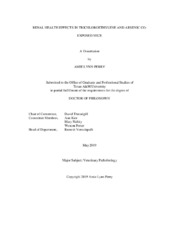| dc.description.abstract | Development of a rodent model for renal cancer and disease development due to toxicant exposure is complicated by differences in renal handling of toxicants between rodents and humans as well as the tendency of rodents to develop significant background spontaneous renal disease that may mimic pre-neoplastic disease or mask more subtle lesions. Classical toxicological studies often focus on one toxicant in a genetically homogeneous population, despite attempting to model human exposure situations involving genetically heterogeneous populations and exposure to mixtures of toxicants. Given these challenges, it has become clear that toxicological studies must address the effects of genetic variability and the range of sensitivity to toxicity due to this inherent variability. Experimental paradigms that assess and control for as many of the intrinsic and extrinsic factors influencing renal response to toxicant exposure are also needed. In an effort to address these limitations, a mouse model was devised that included genetic heterogeneity, mixtures of toxicants at environmentally relevant concentrations, and diet that reflects a typical western diet to better reflect the exposure conditions of human populations. Despite development of a mouse model that more accurately reflects human environmental toxicant exposure conditions, no primary renal cell tumors were observed in the study. Differences in renal health between exposed and unexposed populations were observed as well as increased evidence of renal disease in male mice compared to females across the entire study population. In the current study TCE exposure did not cause renal cell tumors nor did it increase renal disease when combined with arsenic exposure. Evidence of reduced or equal renal damage from co-exposure was observed in some cases, and we speculate that this is due to a threshold effect of damage from a first toxicant limiting the ability of a second toxicant to cause damage. Additional studies of combined toxicant exposure are needed. | en |


